Lunch & Dinner
The Role of Fermentation in Global Cuisines
You’ll discover how fermentation transforms global cuisines and fosters community, but what hidden flavors and health benefits await your exploration?

Fermentation's role in global cuisines is expansive and impactful. It not only boosts flavor and texture but also enhances nutritional value and health benefits. Through fermentation, you'll find probiotic-rich foods that support gut health and reduce chronic illness risks. Culturally, fermentation connects communities, preserving unique identities through traditional recipes like kimchi and sauerkraut. As you explore various fermented foods around the world, you'll appreciate their remarkable diversity and sustainability aspects. If you're curious about how these processes shape cuisines, there's much more to uncover about fermentation's delicious journey in our culinary landscape.
Key Takeaways
- Fermentation has ancient roots, enriching global cuisines with diverse flavors and essential nutrients since around 6000 BCE.
- It enhances gut health through probiotics and improves the bioavailability of vitamins and minerals in food.
- Fermented foods like kimchi and sauerkraut reflect cultural identities and regional culinary traditions worldwide.
- Sustainable fermentation practices reduce food waste and promote environmental health by utilizing surplus ingredients efficiently.
- Innovations in fermentation technologies are expanding access to diverse, health-oriented fermented products in the global market.
Historical Context of Fermentation

Exploring the historical context of fermentation reveals its ancient roots, tracing back to around 6000 BCE with archaeological evidence of fermented beverages in the Fertile Crescent. This early practice of fermentation laid the groundwork for the development of various fermented foods that have become staples in diets worldwide.
Traditional Japanese foods like Dorayaki (Red Bean Pancake) also highlight the cultural significance of fermentation in enhancing flavors. Historical texts, such as those from the Hippocratic Corpus, highlight the nutritional benefits of these foods, showcasing their role in early dietary guidelines.
As you investigate the cultural significance of fermentation, you'll notice how traditional fermented foods—like kimchi in Korea, sauerkraut in Germany, and miso in Japan—reflect diverse global culinary practices. Each of these foods serves not just as a means of preservation but also as a way to enhance flavors and foster community.
Immigrants have played an essential role in introducing and adapting these traditional foods to new regions, enriching local cuisines. Despite their deep historical significance, the role of fermented foods often gets overlooked in modern nutritional guidelines and food policies.
Recognizing this history can deepen your appreciation for the complex flavors and health benefits these foods offer in today's culinary landscape.
Health Benefits of Fermented Foods

Harnessing the power of fermentation, many traditional foods offer remarkable health benefits that can enhance your overall well-being. Fermented foods are packed with probiotics, which play an essential role in improving gut health. For example, traditional Ethiopian beverages like Tella and Tej provide unique flavors while also contributing to gut health. These beneficial bacteria can enhance digestion and nutrient absorption, making you feel more energized and balanced.
Regular consumption of fermented foods has been linked to reduced risks of chronic conditions, including cardiovascular disease, diabetes, and certain cancers. For instance, probiotic yogurt is known to increase regulatory T cells in individuals with inflammatory bowel disease, supporting immune modulation and gut health.
Fermentation also boosts the bioavailability of vitamins and minerals, converting phenolic substances into active metabolites that improve nutritional profiles. This means that the nutrients you consume are more accessible to your body.
Additionally, the bioactive peptides generated during fermentation provide various health benefits, including anti-diabetic effects and anti-inflammatory properties.
Incorporating fermented foods into your diet can be a simple yet effective way to promote better health, making them a delicious addition to your meals. Embrace these foods and enjoy the multitude of health benefits they offer!
Cultural Significance in Global Cuisines
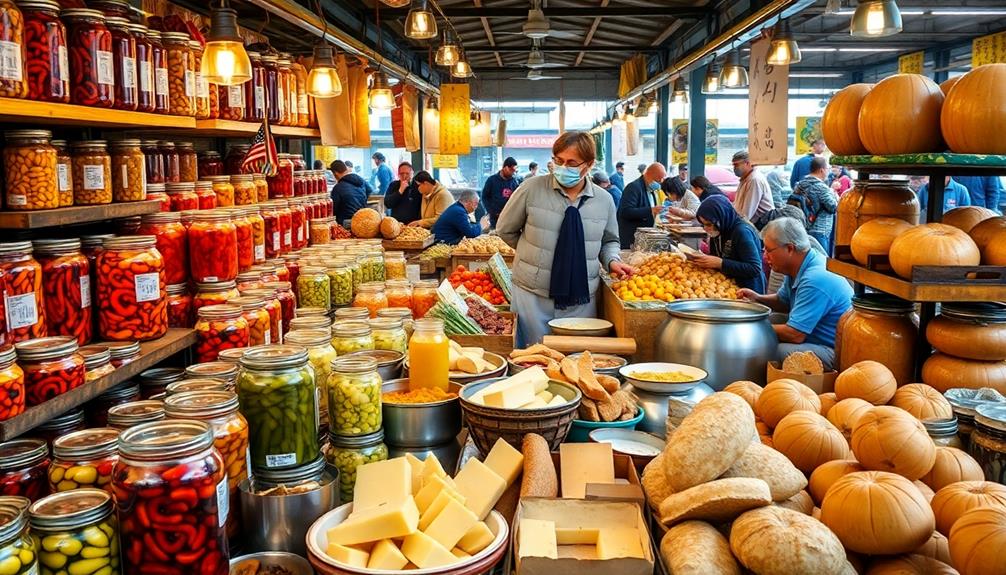
When you explore fermented foods, you'll notice how they reflect the historical roots and unique cultural practices of different regions.
For instance, in Chinese cuisine, dishes like Red-Braised Pork Belly highlight the importance of traditional cooking methods that have been passed down through generations.
Each tradition, whether it's kimchi in Korea or sauerkraut in Germany, offers a glimpse into the local heritage and flavors that have evolved over centuries.
Historical Roots of Fermentation
Fermentation has been a cornerstone of global cuisines for over 10,000 years, shaping food preservation and flavor enhancement across cultures. You'll find evidence of this ancient practice in regions like the Fertile Crescent, where it played a significant role in developing what we now consider traditional fermented foods.
Dishes such as kimchi from Korea, sauerkraut from Germany, and miso from Japan highlight the cultural significance and culinary diversity fermentation brings to various societies. In Korean cuisine, for instance, the fermentation process not only creates complex flavors in dishes like kimchi but also contributes to the dish's health benefits through the presence of probiotics.
As globalization expands, immigrant communities introduce their traditional fermented foods to new areas, influencing local cuisines and fostering appreciation for diverse practices. For instance, kefir and yogurt have made their way into Western diets, showcasing the historical significance and health benefits of these foods.
However, it's essential to recognize that despite their long-standing presence, modern nutritional guidelines often overlook fermented foods' value in dietary practices across cultures.
While globalization increases access to a variety of fermented foods, local production methods persist, ensuring that traditional practices and flavors thrive in contemporary diets. This enduring legacy emphasizes the significance of fermentation in maintaining cultural identity and culinary heritage worldwide.
Cultural Practices and Traditions
Food traditions around the world are deeply intertwined with the practice of fermentation, reflecting the cultural significance of these age-old methods. Fermented foods aren't just about preservation; they're a celebration of cultural practices and community bonding.
Take Korea, for example, where the art of making kimchi has been passed down for over 2,000 years, showcasing traditional recipes that embody national identity. In Brazil, fermentation also plays a role in traditional dishes, highlighting the rich blend of regional influences that shape its diverse cuisine.
In Japan, miso production highlights regional variations, with each area presenting its unique style, influenced by local ingredients and customs. Similarly, in South Africa, kaffir beer, made from fermented maize, plays an essential role in community gatherings, fostering social connections.
Even in Sweden, surströmming, a fermented fish dish, illustrates how regional techniques and local culinary traditions shape food practices.
Additionally, as immigrant communities settle in new regions, they adapt traditional fermented foods, enriching the local culinary landscape and promoting the cultural significance of fermentation in global cuisines. These practices not only preserve flavors but also connect you to the past, emphasizing the importance of community and tradition in your culinary journey.
Global Variations in Fermented Foods
Across the globe, you'll discover a vibrant tapestry of fermented foods, each telling a unique story tied to its culture and heritage. For instance, kimchi in Korea, sauerkraut in Germany, and miso in Japan highlight the cultural significance of these traditional fermentation methods. These practices reflect regional culinary traditions and the availability of local ingredients.
In India, fermented foods like dosa, made from fermented rice and lentils, showcase the importance of fermentation in creating unique textures and flavors in meals, such as Mushroom Masala, which is often accompanied by rice or Indian bread.
Fermented beverages like kefir from the Caucasus and kombucha from East Asia further showcase the diversity of fermentation in drink production. As the globalization of food expands access to these delicacies, local production remains crucial, preserving unique flavors and methods, such as dosa in India.
Communal meals often celebrate fermented foods, emphasizing their role in nutrition and social bonding. Festivals around the world highlight these dishes, reinforcing cultural identity and the importance of shared culinary experiences.
Global Examples of Fermented Foods
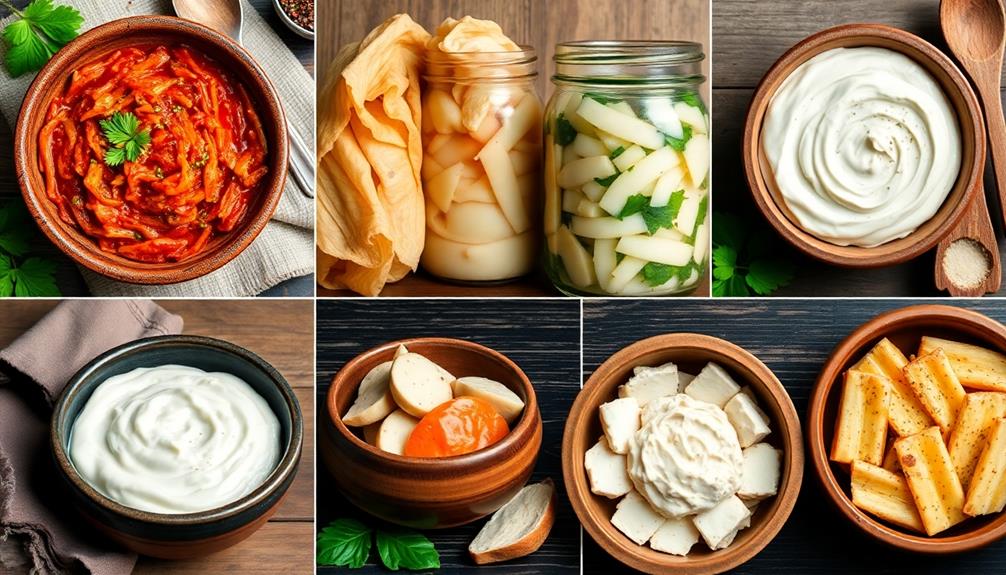
From the spicy crunch of kimchi to the tangy depth of miso, the world offers a rich tapestry of fermented delights that reflect diverse culinary traditions.
In Korea, you'll find kimchi, a vibrant dish made from fermented cabbage and spices, showcasing the bold flavors of Korean cuisine. Similarly, in Mexico, dishes like Chilaquiles utilize fermented ingredients such as salsa to enhance their taste profile.
Germany, on the other hand, boasts sauerkraut, another take on fermented cabbage, which pairs beautifully with sausages and hearty meals.
In Japan, miso serves as a staple fermented soybean paste, enriching soups and sauces with its umami depth.
Over in South Africa, traditional beverages like kaffir beer, crafted from kaffir maize and Lactobacillus sp., highlight local fermentation practices and cultural significance.
Exploring India, you can savor dosa, a fermented crepe made from rice batter and lentils, utilizing beneficial bacteria to enhance flavor and digestibility.
Finally, Sweden's surströmming, a fermented herring dish, presents unique flavor profiles often enjoyed during cultural rituals.
These fermented foods not only tantalize your taste buds but also connect you to the rich histories and practices of their respective cultures.
Nutritional Enhancements Through Fermentation

Harnessing the power of fermentation, many traditional foods undergo transformations that considerably enhance their nutritional value. For instance, dishes like Muamba De Galinha, a traditional Angolan chicken dish, often incorporate fermented ingredients that add depth and complexity to their flavors while boosting health benefits.
When you enjoy fermented foods, you're not just savoring unique flavors; you're also benefiting from increased digestibility. The fermentation process breaks down complex compounds, making nutrients more bioavailable for your body. This means you absorb more goodness from your meals.
Moreover, fermented foods are rich in probiotics—live microorganisms that support gut health. Regular consumption can improve your immune function, helping you fend off illnesses. You'll also find that fermentation boosts the levels of bioactive compounds, like B vitamins and antioxidants, which are essential for overall wellness.
Additionally, fermentation reduces anti-nutritional factors such as phytates and tannins, enabling better nutrient absorption. By incorporating fermented foods into your diet, you may lower your risk of chronic conditions, including cardiovascular disease, obesity, and certain cancers.
With all these benefits, you can see why fermentation plays an important role in enhancing the nutritional value of your meals while promoting a healthier lifestyle. So, why not explore various fermented options in your cuisine?
Fermentation and Sustainable Practices

Fermentation isn't just about flavor; it's a key player in sustainable food practices that benefit both you and the planet.
By enhancing nutritional value and reducing waste, it supports healthier diets and more resilient agricultural systems.
For instance, fermented foods like Nettle and Potato Soup can be a delicious way to utilize seasonal ingredients.
Embracing diverse fermented foods can help you contribute to a more sustainable future while honoring cultural traditions.
Environmental Benefits of Fermentation
How can fermentation transform our approach to sustainability? By embracing fermented foods, you can actively contribute to a more sustainable food system. Fermentation markedly reduces greenhouse gas emissions compared to conventional agricultural practices. It also conserves land and water resources, enhancing the preservation and nutritional value of plant-based foods. Plus, fermented foods help minimize food waste, turning surplus ingredients into valuable products.
Here's a quick look at how fermentation supports sustainable practices:
| Environmental Benefit | Explanation |
|---|---|
| Reduced Greenhouse Gas Emissions | Lower emissions compared to traditional farming. |
| Resource-Efficient Production | Utilizes diverse feedstocks for efficient use. |
| Food Waste Minimization | Transforms by-products into consumable foods. |
| Conservation of Resources | Saves land and water through better preservation. |
| Diversification of Diets | Encourages the use of alternative proteins. |
Nutritional Enhancement Opportunities
Embracing fermented foods not only contributes to a sustainable food system but also offers remarkable nutritional benefits. Fermentation enhances the digestibility and nutritional profiles of plant-based foods, making essential nutrients more bioavailable and reducing anti-nutritional factors found in raw ingredients.
For instance, traditional Polish dishes like Potatoes With Sour Milk showcase how simple ingredients can be elevated through fermentation, emphasizing comfort and health. By incorporating probiotics and bioactive compounds produced during fermentation, these foods can greatly improve your gut health and immunity, potentially lowering the risk of chronic diseases.
Moreover, the fermentation process aligns with sustainable agricultural practices by lowering greenhouse gas emissions and conserving land and water resources. Foods like tempeh and kefir not only diversify your diet but also support food security, as they can be produced with minimal resources while maximizing nutritional output.
When you choose to include fermented foods in your meals, you're not just enhancing flavor but also supporting local agricultural systems and traditional practices.
Incorporating these nutrient-rich fermented foods into your diet fosters a deeper connection to sustainability and ethical food production.
Cultural Significance and Diversity
Across the globe, traditional fermented foods frequently serve as essential components of cultural identity and culinary heritage. Think about kimchi in Korea, miso in Japan, or sauerkraut in Germany; each reflects deep cultural significance and local agricultural practices.
These fermented foods not only celebrate heritage but also enhance the nutritional value of plant-based ingredients, making them more digestible. This aligns with sustainable practices by reducing the reliance on chemical preservatives and extending shelf life.
Moreover, fermentation plays a significant role in food security. By transforming surplus crops into valuable products like yogurt and pickles, it promotes diverse dietary options and minimizes food waste.
The communal preparation of these foods fosters social connections, ensuring knowledge transfer that's critical for maintaining culinary heritage.
As global awareness of sustainable food systems grows, there's a renewed interest in traditional fermentation practices. This shift not only addresses environmental challenges but also promotes health benefits, making fermented foods a key player in today's culinary scene.
Embracing these practices allows you to connect with cultural traditions while supporting sustainability in your own kitchen.
Diversity of Fermented Products
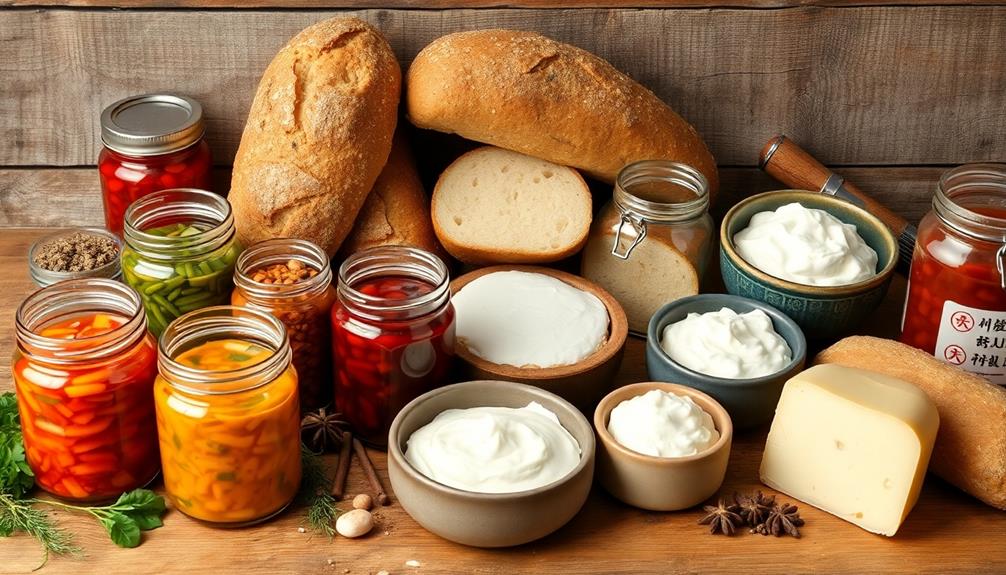
Fermented products offer a fascinating glimpse into the culinary diversity of cultures around the world. You'll find an incredible range of fermented foods, each shaped by unique fermentation processes and local ingredients.
For instance, kimchi from Korea, sauerkraut from Germany, and miso from Japan showcase how different regions utilize their resources to create distinct flavors and textures.
In South Africa, kaffir beer, made from kaffir maize and Lactobacillus species, highlights traditional fermentation techniques, while dosa from India employs lactic acid bacteria to enhance digestibility and flavor.
Sweden's surströmming, fermented herring, demonstrates how preservation methods can elevate seafood in Nordic cuisine.
These examples reflect not just the diversity of fermented foods but also the cultural practices that influence them. Each product carries its own sensory attributes and nutritional properties, making them integral to their respective diets.
Challenges in Fermented Food Production
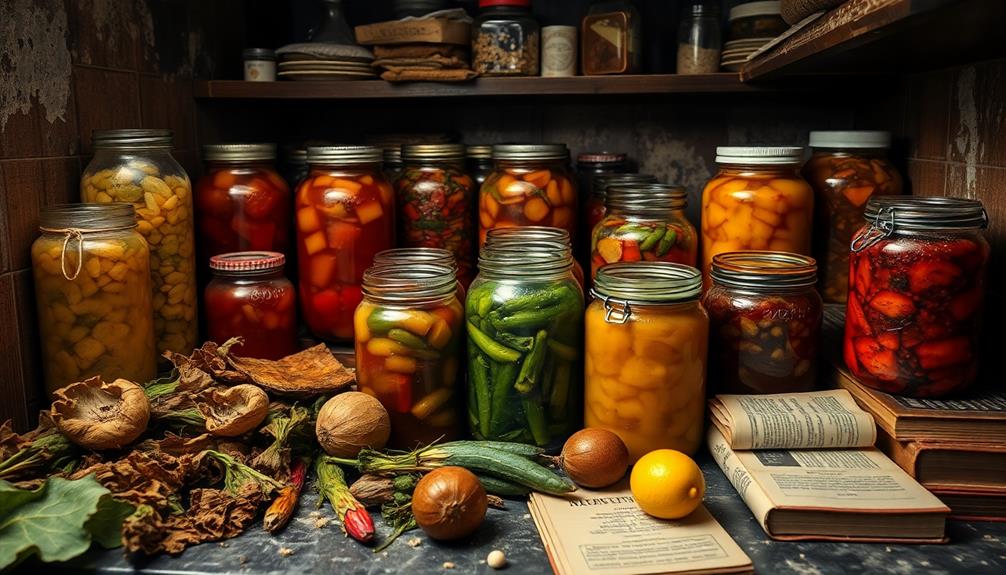
Often, producers face notable challenges in the domain of fermented food production. One major hurdle is the occurrence of undesirable by-products, which can complicate the desired flavor and nutritional profiles of fermented foods.
Additionally, the increased costs associated with fermentation processes, like the need for specialized equipment and quality ingredients, can limit scalability and accessibility.
A decline in traditional knowledge related to fermentation has led to barriers in consumer acceptance, making it tough for regional specialties to thrive. Economic factors also play a vital role; the availability of affordable raw materials greatly impacts production, often disadvantaging small-scale producers when competing against industrial operations.
Moreover, safety concerns regarding the consumption of fermented foods, such as potential allergic reactions or gastrointestinal discomfort, create further challenges. These concerns necessitate ongoing research and monitoring to guarantee public health remains a priority.
As you navigate these production challenges, it's important to balance quality, tradition, and safety to foster consumer trust and acceptance of fermented foods in your offerings.
Policy Recommendations for Inclusion
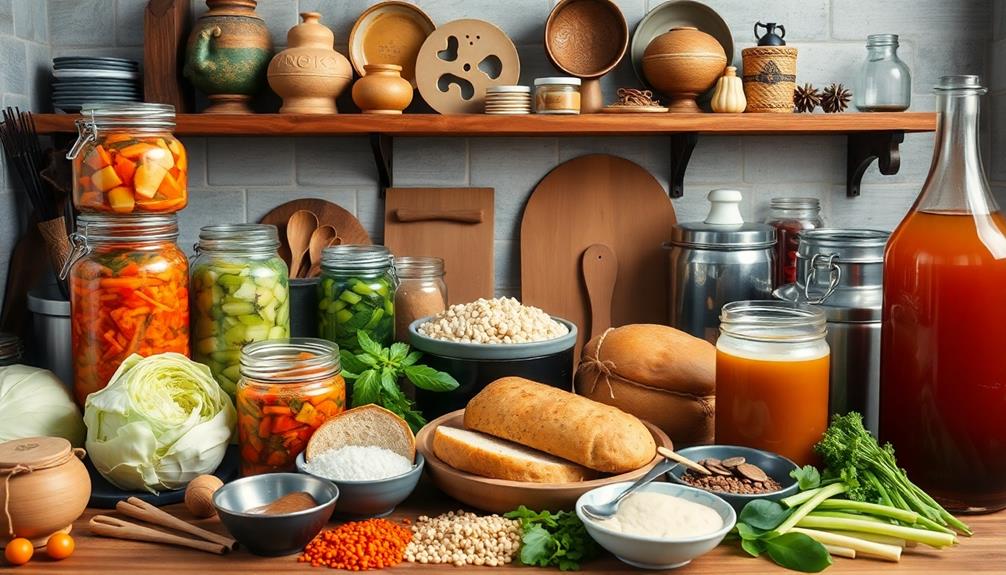
Addressing the challenges in fermented food production opens the door for meaningful policy recommendations that can foster inclusion and recognition of these foods in dietary practices.
First, regulatory agencies like Health Canada should revise nutritional guidelines to acknowledge the health benefits of fermented foods, which can enhance public health by improving gut health and immunity. By incorporating fermented foods into these guidelines, you support diverse cultural practices and promote a more inclusive dietary landscape.
Additionally, policy frameworks can address regional dietary gaps, ensuring that foods like fermented fish, essential in Asia, are represented. This not only promotes cultural relevance in nutrition but also helps bridge the gap in accessibility to these crucial foods.
Health authorities should actively educate the public about the significance of fermented foods, highlighting their historical importance and potential health benefits, including their role in providing probiotics.
Moreover, supporting local production of fermented foods through targeted policy initiatives can increase accessibility and encourage higher consumption rates. This concerted effort can enhance community health and well-being, making fermented foods a staple in everyday diets.
Future of Fermented Foods

As you explore the future of fermented foods, you'll notice emerging trends that emphasize both sustainability and health benefits.
With innovations in fermentation technologies, these foods are becoming more accessible and appealing to health-conscious consumers.
You'll find that the growing demand for plant-based options and probiotics is shaping a vibrant market that supports both your well-being and the environment.
Emerging Trends in Fermentation
In recent years, the landscape of fermented foods has transformed dramatically, driven by a growing consumer appetite for healthier, gut-friendly options. You're likely noticing an increasing availability of plant-based proteins and probiotic-rich products that promise improved digestion and immune support.
Innovations in fermentation technologies, like precision fermentation, are revolutionizing the industry, allowing for scalable production of novel bioactive compounds while addressing sustainable challenges.
Furthermore, there's a notable trend in integrating traditional fermentation techniques with modern biotechnology. This fusion not only enhances flavor profiles and nutritional content but also helps reduce food waste, making your choices more sustainable.
As you explore diverse global cuisines, you might find a resurgence of traditional fermented foods such as kimchi and kefir, which are becoming more popular due to their health benefits and unique tastes.
This cultural exchange fosters culinary innovation, inviting you to experience flavors that span the globe. As the global market for fermented foods continues to grow, it's clear that these emerging trends will shape the future of what you eat, making fermented options more accessible and appealing than ever before.
Sustainability and Health Benefits
Amidst growing concerns about environmental sustainability and personal health, fermentation emerges as a powerful ally in the quest for healthier diets and eco-friendly food systems. Fermented foods not only enhance the nutritional quality of plant-based diets but also play a critical role in improving food security. With their rich content of probiotics, these foods support gut health and offer numerous health benefits, including better immune function and lower risks of chronic diseases like cardiovascular disease and diabetes.
By converting agricultural waste into valuable food sources, fermentation helps minimize food waste and fosters a circular economy in food production. This aligns perfectly with sustainability goals while meeting the increasing consumer demand for functional foods.
| Sustainability Aspect | Health Benefits | Fermented Foods |
|---|---|---|
| Reduces greenhouse gas emissions | Supports gut health through probiotics | Kimchi, sauerkraut, yogurt |
| Conserves land and water resources | Improves immune function | Kefir, tempeh, miso |
| Enhances digestibility of proteins | Lowers risks of chronic diseases | Kombucha, pickles |
As fermentation technology evolves, it promises a future where food systems are healthier and more sustainable.
Frequently Asked Questions
What Is the Role of Fermentation in the Food Industry?
Fermentation plays an essential role in the food industry by enhancing preservation, flavor, and nutrition. You'll find it in products like yogurt and bread, promoting gut health and offering numerous health benefits you can enjoy daily.
Why Is Fermentation Important in the World?
Fermentation's important because it boosts food flavor, aids digestion, and preserves nutrients. You'll find it enhances your meals while promoting gut health. Plus, it's a sustainable method that reduces waste and resource use.
How Has Fermentation Changed the World?
How has fermentation changed the world? It's transformed food preservation, enhanced flavors, and increased nutritional value. You benefit from diverse diets and innovative products, making meals more exciting and sustainable while reducing food waste globally.
What Are the Uses of Fermentation in Culinary?
Fermentation's used in culinary practices to enhance flavors, preserve foods, and improve digestion. You enjoy yogurt, kombucha, and sourdough, all products of fermentation, which also provide probiotics that boost your gut health and overall well-being.
Conclusion
In the grand tapestry of global cuisines, fermentation weaves threads of history, health, and culture into a vibrant mosaic. As you savor each tangy bite, you're not just indulging in flavors; you're participating in a timeless tradition that nourishes both body and soul. Embracing fermented foods isn't just a culinary choice—it's a celebration of diversity and resilience. So, let's raise a glass of kombucha or enjoy a dish of kimchi, honoring the age-old craft that continues to enrich our lives.
Caterina, with her background as a food scientist and innovative chef, is the driving force behind our product development. Her keen eye for detail and relentless pursuit of perfection guide her as she curates our collection of extraordinary ingredients, beverages, and culinary experiences. Whether she’s sourcing the rarest spices or collaborating with master artisans, Caterina’s passion for elevating the culinary landscape shines through in every new discovery that graces our shelves.
Lunch & Dinner
How to Sharpen Knives Like a Professional Chef
Just like a professional chef, mastering the art of knife sharpening can elevate your culinary skills—discover the essential techniques to keep your blades razor-sharp.

To sharpen knives like a professional chef, start by evaluating your blade's dullness. Use a manual sharpener or whetstone, pulling the knife through the coarsest slot 3-6 times before refining it. For even precision, consider an electric sharpener. Regularly hone your knives to maintain sharpness and inspect them under light for any micro-chipping. Always clean and dry your blades after use to prevent rust. Choosing the right technique and tool is crucial depending on your knife type. If you want to elevate your knife skills further, there's plenty more to discover about maintaining their edge and performance.
Key Takeaways
- Choose the right sharpening tool: use whetstones for high-carbon steel knives and manual sharpeners for quick maintenance.
- Maintain a consistent angle of 15 to 20 degrees while sharpening to achieve optimal edge precision.
- Regularly inspect knife edges under light to identify dullness or micro-chipping before each use.
- Hone knives before each use with honing steel to realign the blade and prolong sharpness.
- Clean and dry knives immediately after use to prevent corrosion and ensure long-lasting performance.
Essential Knife Sharpening Tools

When it comes to keeping your kitchen knives in top shape, having the right sharpening tools is essential. Just like using fresh ingredients is key in farm-to-table cooking, having the right tools can elevate your culinary experience.
You've got several options to take into account, each suited for different needs. Manual sharpeners like the Mueller 4 in 1 are perfect for home use, offering multiple slots for various sharpening requirements. The Tumbler Rolling Sharpener provides unique angle settings, making it user-friendly.
If you prefer a more advanced option, electric sharpeners like the ChefsChoice 1520 deliver precision for both flat and serrated blades. They're great for beginners who want a foolproof experience.
For those who enjoy a hands-on approach, traditional whetstones like the King Whetstone Starter Set allow for a customizable sharpening experience. With grits ranging from 1,000 for shaping to 6,000 for refinement, you'll gain skill over time.
Don't forget about honing steels, which are vital for regular maintenance. They help keep knife edges aligned and prolong sharpness between your more intensive sharpening sessions.
No matter which tool you choose, make sure you have a stable cutting board to support your work and protect your knives as you sharpen them.
Step-by-Step Sharpening Techniques

To sharpen your knives effectively, start by evaluating how dull the blade is, as this will guide your choice of sharpening method.
If you prefer manual sharpeners, begin with the coarsest slot. Pull the knife through steadily 3-6 times, then switch to finer slots to refine the edge.
For electric sharpeners, follow the instruction manual closely. Pull the knife through the coarse slot at an even speed, then repeat on the other side before moving on to the finer slots. A sharp knife is essential for preparing ingredients, whether you're slicing pork belly for a rich Red-Braised Pork Belly or cutting vegetables for a revitalizing cold noodle dish.
If you're using a whetstone, soak it in water for an hour first. Maintain a consistent angle while pulling the blade across the stone, flipping it to sharpen the opposite side, and rinse the blade periodically to remove metal filings.
Regardless of the method you choose, regularly hone your knife before each use to keep it sharp. Inspect the edge under light to spot any micro-chipping or dullness that could indicate the need for sharpening.
Maintaining Kitchen Knife Sharpness

Maintaining the sharpness of your kitchen knives is just as important as the sharpening techniques you use. Regularly inspect your knife edges under light to check for micro-chipping or dullness. Depending on how often you use your knives, it might be time to sharpen them 1-2 times a year or even monthly.
Incorporating skills from culinary traditions can enhance your knife techniques, just as Brazilian cuisine highlights the importance of using the right tools for the right dishes. Before each use, grab a honing steel to realign the blade edge. This quick action helps prolong sharpness and reduces the need for frequent sharpening.
When it's time to sharpen, choose the right tool: manual sharpeners work well for basic maintenance, while whetstones offer precise control and customization of your blade shape.
After using your knives, clean and dry them immediately to prevent corrosion, which can seriously affect sharpness and longevity.
Finally, store your knives properly in a knife block, on a magnetic strip, or in sheaths. Proper storage avoids dulling and accidental damage, ensuring your knives remain in peak condition for every culinary task.
With these practices, you'll keep your kitchen knives sharp and ready for action.
Special Considerations for Knife Types

When it comes to sharpening different types of knives, you need to take into account their unique features.
For instance, understanding the culinary traditions from around the world can enhance your appreciation for various knife styles used in diverse cuisines.
Ceramic knives, for example, require specific tools and techniques to prevent chipping, while specialty blades like serrated knives call for tailored methods.
Knowing how to maintain and sharpen each type will help you keep your entire collection in top shape.
Ceramic Knife Sharpening Tips
Sharpening ceramic knives requires a different approach than sharpening traditional steel blades due to their unique properties. Because ceramic knives are made from hard materials, you need to use a whetstone or diamond stone for effective sharpening. Traditional tools simply won't cut it.
To prevent chipping or snapping, always use two hands for stability during the sharpening process. For those who enjoy preparing Indonesian dishes, having a sharp knife is essential for slicing ingredients like fresh herbs or crafting intricate presentations, much like the colorful layers of Layered Cake.
Focus on maintaining the blade angle, ideally between 15 to 20 degrees. Unlike steel knives, don't rely on burr formation. Instead, keep that angle consistent for an effective edge.
When it comes to grit, start with finer grits—1,000 grit or higher works best to achieve a polished edge. This guarantees your knife performs at its best.
Inspect your knife regularly and handle it with care while sharpening. Ceramic knives tend to retain their sharpness longer than steel ones, so a little bit of attention to detail during sharpening can prolong their life considerably.
Maintaining Specialty Knife Blades
Specialty knife blades demand particular care to guarantee peak performance and longevity. When it comes to ceramic knives, remember they're hard and brittle, which makes them prone to chipping. Always use a whetstone or diamond stone for sharpening, and stabilize the knife with both hands to maintain the proper angle—this method is essential since you won't rely on burr formation.
Just like crafting a delicate Dorayaki (Red Bean Pancake) requires precision, so does sharpening these knives.
For high-end Japanese knives, opt for a traditional water whetstone. A dual-grit setup, like 1,000/6,000, is necessary for both shaping and refining the edge. If you're working with specialty serrated knives, use a serrated knife sharpener or honing rod; traditional flat sharpening can damage the teeth.
Additionally, keep an eye on your specialty knives, especially those made from softer stainless steel or intricate designs. Regular inspections and maintenance not only prolong their lifespan but also confirm they perform at their best.
Even for carbon steel blades, routine care is essential to prevent rust and maintain sharpness. By following these tailored maintenance tips, you'll keep your specialty knives in top shape for all your culinary adventures.
Choosing Appropriate Sharpening Tools
Choosing the right sharpening tools is fundamental for maintaining the performance of your knives. Different materials require specific tools to guarantee you don't damage the blade while sharpening. For ceramic knives, use a whetstone or diamond stone; their brittleness makes them susceptible to chipping when using the wrong tools.
Additionally, utilizing the right tools can enhance your culinary skills, much like mastering traditional stuffed pasta techniques in Italian cuisine.
High-carbon steel knives benefit from whetstones or manual sharpeners since electric sharpeners can overheat and ruin the blade. When you sharpen these knives, hold the knife securely to maintain control.
Stainless steel knives typically need less maintenance, but regular honing with diamond steel can help keep the edge sharp without excessive sharpening.
For specialty knives, such as serrated blades, it's important to use a serrated knife sharpener. This tool will preserve their unique cutting edge, which is significant for their performance.
Always select sharpening tools that align with the knife's material and design. This not only optimizes performance but also extends the blade's longevity.
Expert Tips for Knife Care

Regularly caring for your knives can greatly extend their lifespan and maintain peak performance. Start by inspecting the knife edges under light to spot any micro-chipping or dullness. Depending on how often you use them, sharpen your knives 1-2 times a year, or monthly if you're a heavy user. For a fun gathering, consider serving themed dishes like Graveyard Taco Dip to complement your culinary skills.
After each use, clean and dry your knives immediately to prevent corrosion; moisture can lead to rust, which notably reduces the blade's lifespan. Using honing steel before each use makes it much easier to maintain the knife's edge, prolonging sharpness between sharpenings.
Proper storage is also essential. Store your knives in a knife block, on a magnetic strip, or in sheaths to avoid dulling and accidental damage, ensuring both safety and longevity.
Finally, educate yourself on proper sharpening techniques tailored to your knife types. Understanding the right angle and method—whether manual, electric, or whetstone—can enhance performance and efficiency.
Understanding Knife Grip and Cutting Techniques

Understanding proper knife grip and cutting techniques is essential for anyone looking to enhance their culinary skills. A correct knife grip involves pinching the blade near the handle with your index finger and thumb, while your remaining fingers wrap around the handle. This grip enhances stability and control, allowing for greater precision during cutting tasks.
Additionally, mastering these techniques can be particularly helpful when preparing dishes like Mushroom Masala, where fine chopping of ingredients is vital for flavor integration.
When chopping, use the claw grip—curl your fingers under to protect them. This technique also lets your middle finger knuckle serve as a guide for cut thickness, ensuring safety. For slicing delicate items like herbs and garlic, employ a rocking motion with a European-style chef knife, keeping the tip on the cutting board for better control and efficiency.
Moreover, always consider the grain direction in cooked meat. Slicing against the grain yields more tender cuts, making them easier to chew.
Frequently Asked Questions
How Do Chefs Get Their Knives so Sharp?
Chefs get their knives sharp by regularly honing and sharpening them with precision. They use the right angle, practice consistent techniques, and choose high-quality materials, ensuring their tools maintain peak performance for various cutting tasks.
What Do Professionals Use to Sharpen Their Knives?
Professionals use whetstones, electric sharpeners, and honing steels to keep their knives sharp. While some might think it's complicated, these tools help you achieve precision and maintain your blades effortlessly, enhancing your cooking experience.
How to Professionally Sharpen Knives at Home?
To sharpen knives professionally at home, choose your tool wisely, whether it's a whetstone or electric sharpener. Follow instructions, maintain the right angle, and regularly check for dullness to keep your blades efficient.
What Does Gordon Ramsay Use to Sharpen His Knives?
Imagine sculpting a masterpiece; precision matters. Gordon Ramsay sharpens his knives using a whetstone, focusing on a consistent 18-degree angle, blending coarse and fine grits to achieve that perfect edge. Don't forget honing steel for maintenance!
Conclusion
By mastering knife sharpening, you'll not only improve your culinary skills but also extend the life of your tools. Remember, "a dull knife is more dangerous than a sharp one." So, keep those edges keen with the right tools and techniques. Regular maintenance and understanding your knives will make all the difference in your kitchen. With a little practice, you'll be slicing like a pro in no time. Happy cooking!
Caterina, with her background as a food scientist and innovative chef, is the driving force behind our product development. Her keen eye for detail and relentless pursuit of perfection guide her as she curates our collection of extraordinary ingredients, beverages, and culinary experiences. Whether she’s sourcing the rarest spices or collaborating with master artisans, Caterina’s passion for elevating the culinary landscape shines through in every new discovery that graces our shelves.
Lunch & Dinner
Why Chocolate Makes Us Feel Good
As we explore why chocolate boosts our mood, you’ll discover surprising science behind its effects that might just change your perspective on this beloved treat.

Chocolate makes you feel good because it's packed with compounds that affect your brain and mood. Tryptophan boosts serotonin, the happiness hormone, while phenylethylamine (PEA) mimics feelings of love and excitement. Theobromine acts as a mild stimulant, enhancing your overall sense of well-being. Plus, sugar releases dopamine, heightening pleasure. On top of that, chocolate often reminds you of joyful occasions, making it a comforting treat. Just remember, moderation is key for health benefits. Curious about how these effects can play a role in your daily life? You might find the next insights even more interesting.
Key Takeaways
- Chocolate stimulates serotonin production, enhancing mood and promoting feelings of happiness.
- The presence of phenylethylamine (PEA) mimics love sensations, elevating enjoyment.
- Endorphins released during chocolate consumption contribute to overall feelings of satisfaction.
- Flavonols in cocoa improve blood flow to the brain, boosting cognitive function and alertness.
- Theobromine acts as a mild stimulant, providing uplifting sensations and relaxation.
Mood Enhancement Mechanisms

Chocolate's mood-enhancing properties are captivating and rooted in its unique chemical composition. When you indulge in chocolate, you're not just satisfying a craving; you're also stimulating your brain's chemistry to promote feelings of happiness. One of the key components is tryptophan, an amino acid that aids in serotonin production. This neurotransmitter is essential for elevating your mood and fostering positive feelings.
Curiously, just like how a Graveyard Taco Dip can elevate the festive spirit at gatherings, chocolate can create a sense of joy and celebration in your personal moments.
Moreover, chocolate contains phenylethylamine (PEA), which stimulates the pleasure centers in your brain. This chemical is associated with feelings of love and excitement, making each bite feel even more rewarding. Additionally, theobromine, an alkaloid present in chocolate, acts as a mild stimulant, further enhancing the uplifting sensation you experience.
As you savor chocolate, your body also triggers the release of endorphins—natural substances that promote happiness and satisfaction. The sugar in chocolate plays a role too, stimulating dopamine release and creating those pleasurable sensations that keep you coming back for more.
Cognitive Benefits of Chocolate

Indulging in chocolate doesn't just satisfy your sweet tooth; it can also sharpen your mind. The flavonols found in cocoa enhance blood flow to your brain, potentially improving cognitive function and clarity of thought.
Notably, just like the rich flavors of Red-Braised Pork Belly can evoke a sense of comfort, chocolate can create a similar response in our brains, promoting feelings of happiness and satisfaction. When you reach for a piece of dark chocolate, you're not just treating yourself; you're also giving your brain a chance to thrive.
The caffeine in chocolate increases alertness and focus, providing a much-needed mental boost during those sluggish moments. Regular consumption of dark chocolate, rich in antioxidants, has been linked to improved cognitive performance and may even reduce the risk of cognitive decline as you age.
Furthermore, chocolate contains tryptophan, which aids in the production of serotonin, a neurotransmitter essential for better mood regulation and cognitive processing.
Studies suggest that consuming chocolate can lead to a temporary increase in cognitive abilities, making it a valuable tool for tackling demanding tasks.
Natural Feel-Good Effects

Often overlooked, the natural feel-good effects of chocolate can greatly boost your mood. When you indulge in chocolate, your brain kicks into gear, stimulating the production of serotonin, a key player in promoting feelings of happiness and well-being. The tryptophan in chocolate helps synthesize this serotonin, enhancing its mood-lifting properties.
Just like the comforting flavors of Mushroom Masala can elevate your dining experience, chocolate can elevate your spirits.
As you savor chocolate, your body releases endorphins, those natural chemicals that elevate your mood and create a satisfying sensation. You might even feel a rush of excitement due to phenylethylamine (PEA), which stimulates pleasure centers in your brain, mimicking the sensations of love and thrill.
Additionally, theobromine, an alkaloid found in chocolate, offers a mild stimulant effect that brings about feelings of relaxation and stress relief.
Cultural and Psychological Influences

Embracing chocolate as a comfort food reveals its deep-rooted cultural and psychological significance. You probably reach for chocolate during times of emotional distress, finding it a reliable psychological remedy for sadness or stress. This connection isn't just personal; cultural associations link chocolate to celebrations and rewards, enhancing your feelings of happiness.
In many cultures, including Brazilian cuisine, sweets like Brigadeiro are often associated with festive occasions, further embedding these treats into our emotional lives.
Consider these influences:
- Celebratory moments: Chocolate often marks special occasions, reinforcing positive experiences.
- Social bonding: Sharing chocolate during gatherings fosters connections with others, making it a communal delight.
- Nostalgia: The taste and smell of chocolate can evoke fond memories, adding to your overall well-being.
- Media portrayal: Advertisements often depict chocolate as a solution to emotional issues, shaping your perception of its benefits.
- Comfort food status: When you indulge in chocolate, it serves as a familiar comfort that provides solace.
Together, these factors create a rich tapestry of experiences that make chocolate more than just a treat; it's a source of joy that transcends individual moments and connects you to broader cultural narratives.
Health Considerations and Moderation

When it comes to enjoying chocolate, health considerations and moderation play essential roles in your overall well-being. While dark chocolate is known for its higher antioxidant content and potential heart health benefits, indulging excessively can lead to health issues like weight gain and increased sugar content.
You might enjoy the feelings of happiness that chocolate brings, but it's vital to balance your choices. Incorporating elements of a balanced diet, such as the nutrient-rich Nettle and Potato Soup, can further enhance your health while enjoying treats like chocolate.
Moderation is key. Opt for dark chocolate over milk chocolate to maximize health benefits while minimizing sugar intake. Even small amounts of dark chocolate can boost serotonin levels, enhancing your mood without the risk of overindulgence.
Be mindful of how much you eat; awareness of chocolate's addictive potential can help you maintain a healthy relationship with sweets.
As ongoing research sheds light on chocolate consumption, it reinforces the importance of moderation. You can savor the delightful taste and experience the positive effects without compromising your health.
Frequently Asked Questions
Why Does Eating Chocolate Make Me Feel Better?
Eating chocolate can lift your mood because it boosts serotonin levels in your brain, releases feel-good chemicals, and mimics the blissful sensations of love. You're indulging in a delicious treat that enhances your happiness.
Why Is Chocolate so Satisfying?
Chocolate's satisfying nature comes from its rich flavors and textures, engaging your taste buds. The combination of sweetness and creaminess creates a delightful experience, making each bite a pleasurable moment you can't resist.
Why Does Chocolate Cheer You Up?
When you unwrap that chocolate bar, you're diving into a world of endorphins and serotonin. It not only lifts your mood, but it also comforts you, reducing stress and bringing back sweet memories.
Why Does Chocolate Calm Me Down?
When you eat chocolate, it calms you down because it releases theobromine and serotonin, which ease stress. The sugar boosts dopamine levels, making you feel satisfied and relaxed, enhancing your overall mood and tranquility.
Conclusion
In the end, chocolate isn't just a treat; it's a hug for your soul. With each bite, you reveal a treasure chest of joy, lifting your spirits like a warm breeze on a chilly day. It dances on your taste buds, igniting memories and comfort. Just remember, moderation is key—like savoring a beautiful sunset, you want to cherish the moment, not let it fade away. So go ahead, indulge a little, and let the sweet magic wash over you.
Caterina, with her background as a food scientist and innovative chef, is the driving force behind our product development. Her keen eye for detail and relentless pursuit of perfection guide her as she curates our collection of extraordinary ingredients, beverages, and culinary experiences. Whether she’s sourcing the rarest spices or collaborating with master artisans, Caterina’s passion for elevating the culinary landscape shines through in every new discovery that graces our shelves.
Lunch & Dinner
The Cultural Significance of Bread Around the World
Savor the diverse cultural significance of bread around the world, as its rich traditions and communal bonds reveal deeper connections yet to be explored.
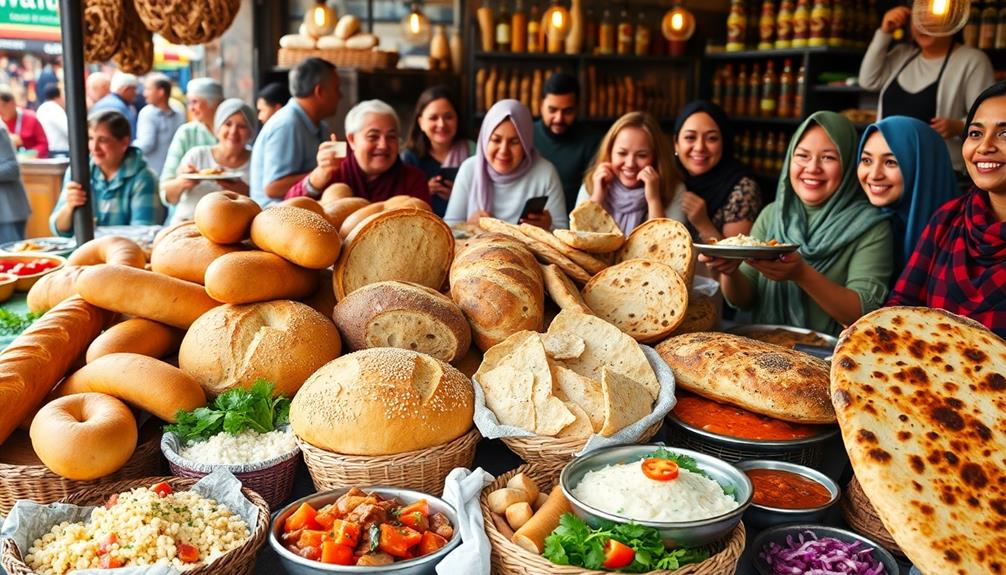
Bread holds immense cultural significance across the globe, woven into traditions, diets, and social practices. You'll find sourdough in Greece symbolizing hospitality, while pita in the Middle East serves as a communal tool for sharing meals. Religiously, bread represents connection and life, seen in Christian rituals and Jewish celebrations. Economically, it reflects stability, with fluctuations affecting societies profoundly. In recent years, home baking trends have surged, highlighting a return to traditional practices and self-sufficiency. As you explore further, you'll uncover even more fascinating aspects of bread's role in cultures worldwide.
Key Takeaways
- Bread has been a staple food for over 14,000 years, symbolizing life and sustenance in various cultures, particularly in the Middle East and ancient Egypt.
- Different regions feature unique bread varieties, such as Greece's Horiatiko Psomi and Germany's 1,300 types, reflecting cultural diversity and culinary heritage.
- In many religions, bread holds significant symbolism, representing community, hospitality, and divine provision, as seen in Christianity, Judaism, and Eastern European traditions.
- Bread's economic impact is profound; it can indicate stability, influence prices, and has historically served as currency, emphasizing its societal importance.
- Contemporary trends show a resurgence in home baking and interest in artisan and gluten-free breads, highlighting evolving cultural practices and health consciousness.
Historical Origins of Bread

The fascinating journey of bread begins over 14,000 years ago with the Natufian culture in the Middle East. Here, archaeological evidence, such as burnt breadcrumbs, shows that early bread-making practices were already taking shape. The domestication of wheat and barley in the Fertile Crescent during the Neolithic era marked a significant milestone, establishing bread as a staple food across various cultures.
Charred bread crumbs discovered in Jordan, dating back 14,600-11,600 years, suggest that bread-making occurred even before agriculture began, highlighting its ancient roots.
As you explore the history of bread, you'll find that it held immense cultural significance, especially among the ancient Egyptians. They referred to bread as "aish," which means life, and it became a fundamental part of their diet, eaten by all social classes, including pharaohs.
Notably, similar to how bread has become a staple across cultures, traditional Brazilian dishes showcase the importance of staple foods in community and culinary practices.
The evolution of bread-making techniques, like the introduction of sourdough starters and freestanding ovens by the Greeks, reflects advancements in culinary practices throughout history.
This universal food hasn't just nourished people but also served as a symbol of community and sustenance, connecting generations through shared traditions and experiences.
Bread Varieties Worldwide

Across the globe, bread varieties reflect the rich tapestry of cultural traditions and culinary practices unique to each region. You'll find that different types of bread serve essential roles in daily life, showcasing the nutritional value and historical significance tied to great civilizations.
For instance, Greece is known for its traditional Horiatiko Psomi (Country Bread), which symbolizes hospitality and is often enjoyed with olive oil and cheese.
- Germany boasts over 1,300 varieties of bread, making it the leader in per capita bread consumption.
- In Latin America, traditional breads like sopaipillas, arepas, and chipa highlight the region's diverse culinary heritage.
- Asian staples such as Sangak, mantou, and chapati demonstrate various bread-making techniques across the continent.
- In the Middle East, pita bread acts as a pocket for fillings, embodying the communal eating traditions of the region.
In North Africa, injera serves not just as a dish but also as an eating utensil, showing its integral role in cultural dining experiences.
These bread varieties are more than just food; they reflect the cultural and religious practices that bind communities together. Whether it's a simple flatbread or a complex sourdough, each loaf tells a story of the people who cherish it.
Religious Symbolism of Bread

Bread carries profound religious symbolism in various traditions, serving as a bridge between the material and spiritual domains. In Christianity, you'll find that bread represents the Body of Christ during the Eucharist, a sacrament that's central to worship and community gatherings. This act of sharing bread reinforces bonds among believers, highlighting the importance of unity in faith.
Similarly, in Italian culture, traditional dishes like agnolotti often accompany communal meals, emphasizing the role of food in fostering connection among family and friends.
In Judaism, challah takes center stage during Shabbat and holidays, symbolizing divine provision and the sanctity of rest. During Passover, unleavened bread, or matzo, commemorates the Israelites' hasty escape from Egypt, emphasizing freedom and the significance of remembrance in Jewish culture.
Globally, bread plays an essential role in ceremonial offerings and rituals, often embodying hospitality and abundance. For instance, the Bread and Salt tradition in Eastern Europe signifies welcome and friendship, where guests are presented with these staples as tokens of sustenance and community connection.
Through these diverse traditions, bread transcends mere sustenance, becoming a powerful symbol that unites culture, community, and spirituality across various faiths and practices.
Economic Impact of Bread
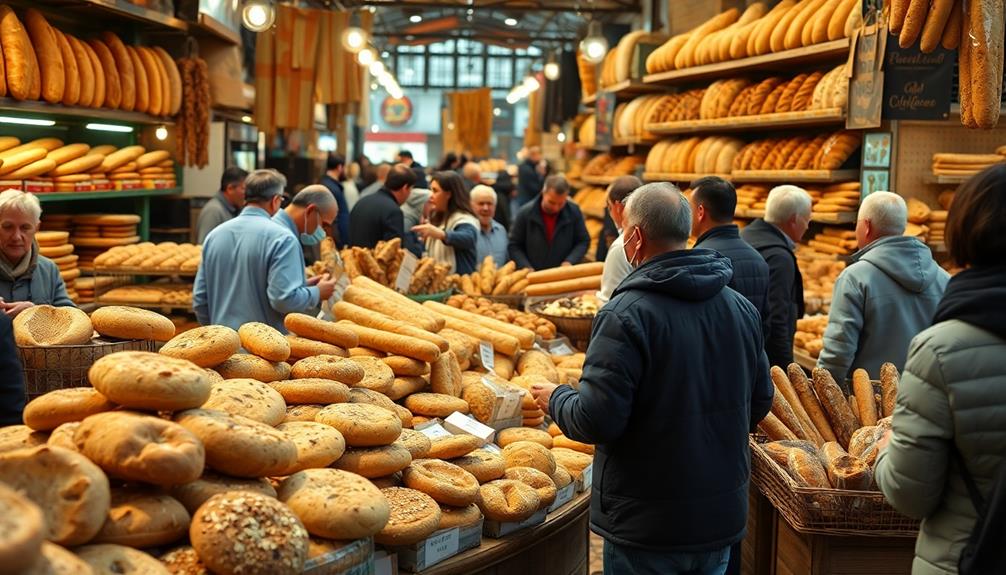
Throughout history, bread has shaped economies and influenced social structures in profound ways. As a staple food, its impact on your daily life and community is undeniable.
Bread's cultural significance goes beyond nourishment; it's an essential indicator of economic stability. When bread prices rise, it doesn't just affect your grocery bill—it can lead to civil unrest and social upheaval. For example, in some regions, the price of basic foods like rice or wheat can mirror the complexities of economic health, similar to how Red-Braised Pork Belly reflects cultural traditions during gatherings.
Consider these key points:
- In Ancient Egypt, bread and beer served as currency, ensuring fair nutrition for workers.
- The Roman Empire regulated bread prices; shortages often sparked riots, revealing bread's economic importance.
- Historical events, like the Flour War in France, show how rising bread prices can ignite significant unrest.
- For many families, bread consumes 60-80% of their income, highlighting its role in economic health.
When grain prices fluctuate, as seen during WWI, the consequences extend beyond the kitchen table. Bread is more than just loaves; it represents stability, unity, and sometimes, a catalyst for change.
Understanding this connection can deepen your appreciation for bread's place in both history and society today.
Contemporary Baking Trends
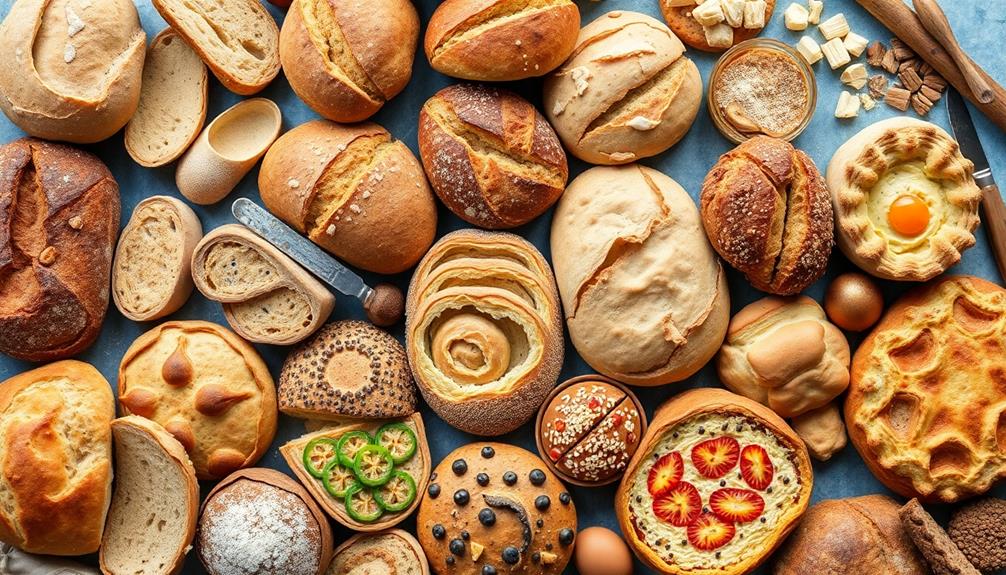
In recent years, home baking has experienced a dramatic revival, with a 400% increase in sourdough starter sales reported during the COVID-19 pandemic. As people sought stress relief and creative outlets, they turned to baking as a fulfilling hobby.
This shift also sparked a trend towards self-sufficiency, with many making their own self-raising flour amid ingredient shortages. Additionally, the growing interest in fresh, seasonal ingredients has led many home bakers to incorporate local produce into their creations, such as using farm-to-table cooking techniques to enhance flavors.
You've likely noticed the growing interest in artisan and organic bread, with sales of organic options in the U.S. rising by 33% from 2015 to 2020. This reflects a demand for healthier and more sustainable choices.
Social media platforms like Instagram and TikTok have been instrumental in popularizing baking trends, leading to viral recipes and challenges that inspire a wider audience to try their hand at bread-making.
Moreover, the gluten-free movement has gained significant momentum, with the gluten-free bread market projected to reach $7.6 billion by 2026. This trend is driven by increasing health consciousness among consumers, who are keen to explore various alternatives.
Frequently Asked Questions
What Is the Significance of Bread in Different Cultures?
Bread's significance varies across cultures; you'll find it symbolizes sustenance, community, and tradition. It's often present in rituals, meals, and celebrations, reflecting local ingredients and practices that unite people through shared experiences and values.
What Is the Historical Significance of Bread?
Bread's historical significance lies in its role as a sustenance staple, a symbol of life, and a means of societal control. It's been essential in revolutions and religious rituals, shaping economies and cultures throughout time.
Why Is Bread a Staple Food in Countries Around the World?
You'll find bread's warm embrace in every corner of the globe. It fuels your day, binds meals together, and celebrates local flavors, making it a beloved staple that nourishes hearts and homes everywhere you go.
What Is the Purpose of Bread for the World?
Bread serves multiple purposes: it nourishes you, brings people together, and represents culture. You rely on its versatility for meals, while its presence in rituals and traditions deepens your connection to community and heritage.
Conclusion
In exploring the cultural significance of bread, you can see how it intertwines with history, spirituality, and economics across the globe. Did you know that over 20,000 different types of bread exist worldwide? This staggering number highlights bread's versatility and its role in diverse cuisines. As you break bread with others, remember the rich stories and traditions each loaf carries, connecting people and cultures throughout history. Bread isn't just food; it's a universal symbol of community.
Caterina, with her background as a food scientist and innovative chef, is the driving force behind our product development. Her keen eye for detail and relentless pursuit of perfection guide her as she curates our collection of extraordinary ingredients, beverages, and culinary experiences. Whether she’s sourcing the rarest spices or collaborating with master artisans, Caterina’s passion for elevating the culinary landscape shines through in every new discovery that graces our shelves.
-

 Italian Cuisine5 months ago
Italian Cuisine5 months agoWhat Italian Dishes Use Parsley
-

 Vetted4 months ago
Vetted4 months ago12 Best Coffee Pods for DeLonghi Espresso Machine to Elevate Your Caffeine Game
-

 Vetted4 months ago
Vetted4 months ago15 Best Commercial Automatic Espresso Machines for Your Coffee Shop
-

 Vetted2 months ago
Vetted2 months ago15 Best Coffee Beans for Your Breville Espresso Machine – Expert Picks for Perfect Brews
-

 Vetted2 months ago
Vetted2 months ago15 Best Coffee Beans to Elevate Your Breville Espresso Experience
-

 Vetted2 months ago
Vetted2 months ago15 Best Non-Toxic Espresso Machines for a Healthier Brew at Home
-

 Vetted5 months ago
Vetted5 months ago15 Best ESE Pod Espresso Machines for Perfect Coffee Every Time
-

 Halloween-themed Recipes2 weeks ago
Halloween-themed Recipes2 weeks agoSpiderweb Black Bean Dip




























